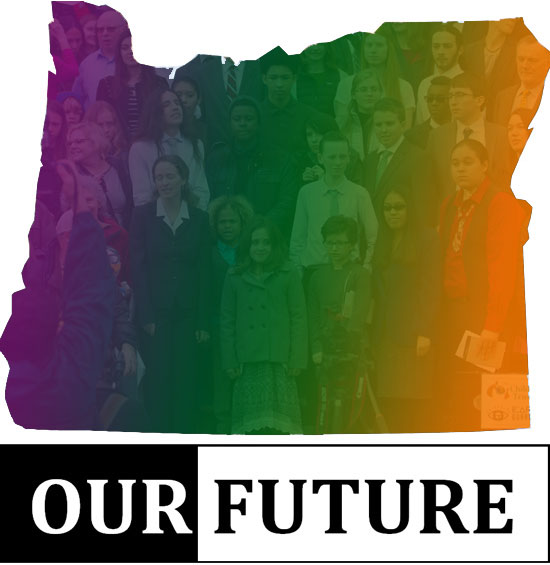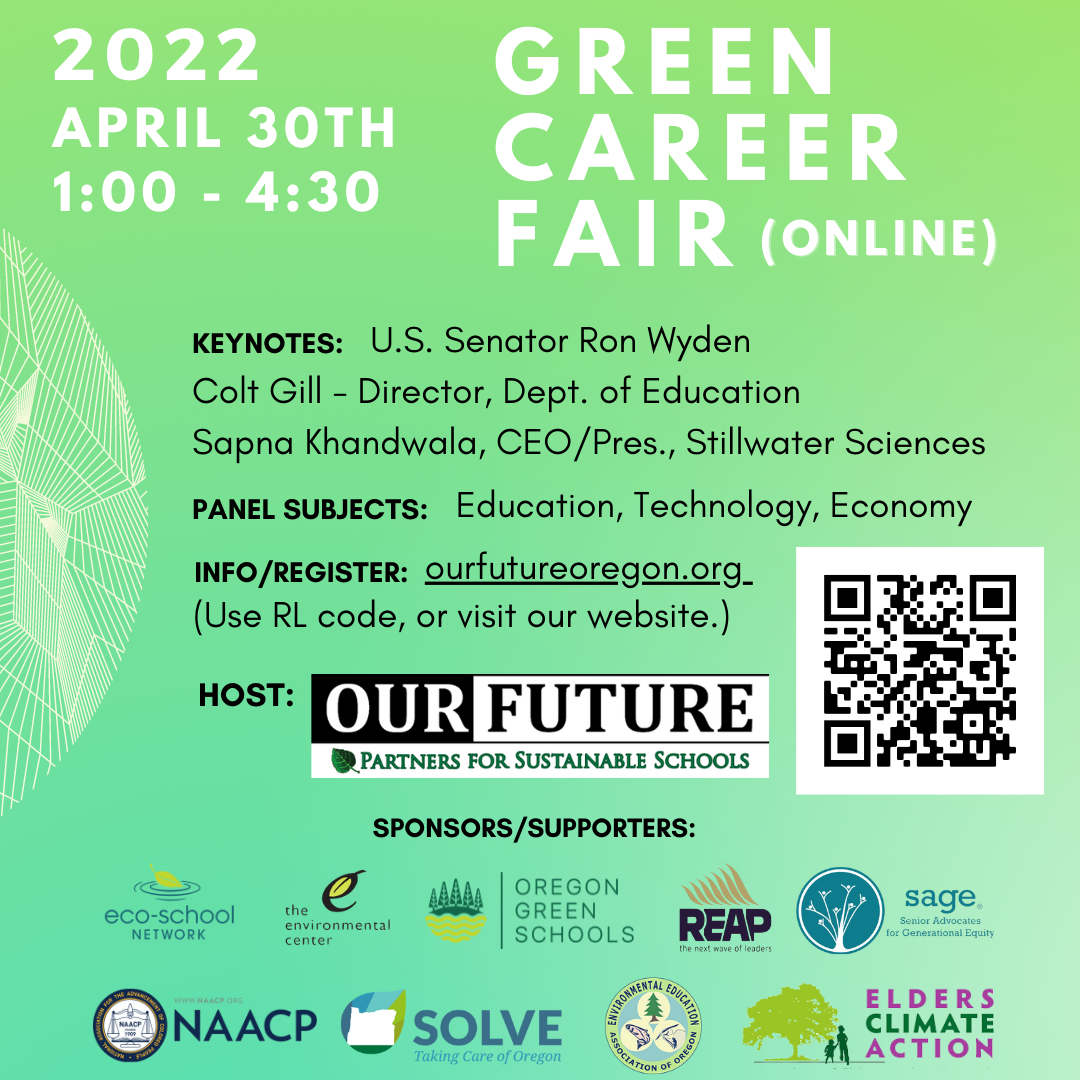Our Future Newsletter: April 2022
Thank you for staying informed about what Our Future is working on, both in individual schools and as a statewide network. The newsletter content is primarily produced by Our Future’s Regional Leaders team and the OF Newsletter Committee–to suggest content or to provide feedback, please use the comment form at the bottom of the page.
In This Issue:
Current OF Events:
Green Career Fair and Climate Education Survey!
(Content written by Our Future staff)
April is an exciting month for Our Future! Here are a couple of ways ALL students can get involved in climate action this month:
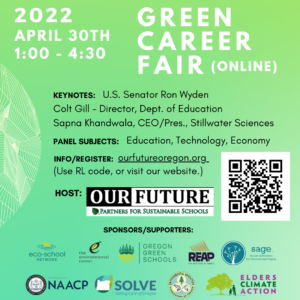
- Register for our upcoming Green Career Fair! We are excited to host a virtual (Zoom) career fair with professionals from a variety of “green career” fields, as well as representatives from University of Oregon, Oregon State University, Portland State University, Southern Oregon University, and Lane Community College to highlight different educational opportunities that will prepare you for working in the new green economy. For more details on this event, please check out our webpage for the event. You can also jump straight to the event brochure, or visit the registration page HERE.
- Take the Oregon Educators for Climate Education (OECE) Survey! OECE is a group of dedicated teachers, administrators, and community members who are working to create legislation that will create a framework for K-12 climate education throughout the state of Oregon. A first draft of the legislative language (to be introduced in the 2023 legislative session) has already been written and the steering committee is requesting student and teacher feedback on the core concepts embedded in the legislation. Please voice your opinion on this first draft by filling out this quick survey, and please share with friends. Your voice matters–it’s your educational experience!
Leadership Tips
(Content Written by Maya Schwartz, Crescent Valley HS)
Being an environmental leader sounds like a daunting title, led by activists like Greta Thunberg, David Attenborough, and Leah Thomas, who are dedicating their lives to educating people about the environmental issues we face. But what if I told you that we all have the capabilities to be an activist in our own sense, even within our own communities? Activism is a broad term that doesn’t have to mean saving the world in one fell swoop, but rather, observing inconsistencies, inequalities, and abuses, and motivating to make change.
Steps to get you started on your activism journey include simply finding relevant interests:
- What are you passionate about?
- What is occurring in your environment?
You can also consider viable options for action within your community! Choose something that your audience can relate to and be passionate about:
- What have you noticed in your environment?
- What is the activist climate in your community; are there invested community members?
- What are environmental issues going on in your community?
Finding supportive platforms to help spread the word is also extremely effective:
- What are some local organizations that support the environment?
- What are some school clubs or functions that I could affiliate myself with?
- Get in touch with a higher up! Bring the issue to the attention of the law and push for legislation!
Even exchanging ideas with your peers and your friends is a great way to get the conversation started about activism in your community! You have more power than you think, and remember, the world can’t be saved in only one day. Be patient with the process, and find environmental allies; Our Future is always here to guide you as well! Don’t be afraid to speak up and speak out; the future of our planet relies on our collective voices.
Project Spotlight: Caldera HS Pollinator Garden
(Content written by Maddie Joyce, Caldera HS)
If you’re looking for a way to make your school more eco-friendly, a pollinator garden using native plants from your area is a great idea. A pollinator garden can be used as a fun hands-on learning opportunity in your school, as native pollinator gardens especially create opportunities for learning about the wildlife and biology in your area. I’m going to inform you on the educational value of a pollinator garden, steps to get administrative approval, and how to create a garden, as well as how humans have had an impact on pollinators and how pollinator gardens can help.
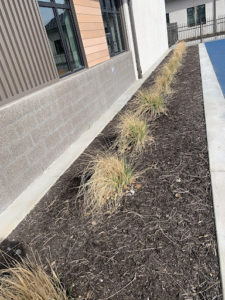
In the US, herbicides and pesticides have taken part in causing bee populations to decline 30% in the last 15 years due to CCD (colony collapse disorder). Pollinators’ habitats are being replaced with neighborhoods and cities, leaving the pollinators without the necessities they need to thrive. Pesticides and herbicides contaminate the plants pollinators use to pollinate, and can make the pollinators and native plants sick. Building a pollinator garden can create a safe space for pollinators that have been displaced in your communities.
Native pollinator gardens can help relieve this problem in your community, and provide great educational value because of hands-on learning opportunities and the chance to educate students on the depletion of pollinators. Pollinator gardens are a great resource for hands-on learning activities as well. Any school with a woodshop class can help by building planter boxes, biology and ecology classes can greatly benefit by using the garden to see what they’re learning up close, and gardens can provide an easy and fun way for life-skills students to learn and engage in the same educational opportunities as their peers. A pollinator garden can be a great educator about what challenges pollinators are facing, as well as solutions like the garden itself.
Sometimes there are challenges to starting a garden at your school, especially when it comes to district and administrative approval. Here are some steps you can take before asking for a grant or approval:
- Add up the costs, and create a budget and funding plan.
- Scope out areas of your school to see if you have room for a garden.
- Do you have enough volunteers? Create a maintenance schedule and list of responsibilities.
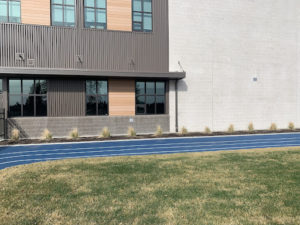
After considering these questions you will need approval from your principal, talk to the outside services manager who oversees maintenance for your district, and you may even need to talk to the school or district board. Once you have approval, create a timeline and apply for grants, this will help you manage your time and budget.
A few questions you need to ask in terms of building and creating a garden are:
- Who will do the upkeep during the school year and summer months?
- What are the costs of that upkeep?
- How many people will it take to build the garden?
You must have the resources and numbers you need to follow through. Talk to local nurseries about native plants and see if you can get a discount for a school garden. These are all important steps to follow if you want to succeed at planting a native pollinator garden.
In the US, due to habitat loss, herbicides and pesticides, and climate change, bee populations have declined 30% in the last 15 years. Pollinators’ habitats are being replaced with neighborhoods and cities, leaving the pollinators without the necessities they need to thrive. Pesticides and herbicides contaminate the plants pollinators use to pollinate and can make the pollinators and native plants sick. Building a pollinator garden can create a safe space for pollinators that have been displaced in your communities.
As you can see, a pollinator garden is a great addition to any school in terms of educational value and how gardens can have a positive impact on pollinators. I believe all students can receive fun and hands-on education that will lead to a better environment at school. For these reasons, I think every school should have a pollinator garden.
Want to know more? Sources for this article can be found HERE and HERE.
Green Tips
Content written by Sunita Kothari, David Douglas HS)
In recent years, there has been an increase in “waste dumping” in our world. According to Global Waste Problem, “Waste dumping has become a way to ‘solve’ the world’s enormous waste problems.” This problem isn’t just in America, but all over the world. Based on scientists, one effect of waste dumping is that air pollution can release toxic substances, which are terrible for the human body to breathe in. There’s also ocean pollution resulting from tons of plastics ending up in the oceans each year, and pollution of soil through dumping waste can negatively affect our food production. The list goes on and on regarding how waste is taking over our world, but we can do better. A few simple ways we can reduce our waste are:
- Use reusable bottles/cups for beverages, not use bottled water, and reduce/reuse/recycle the amount of packaging you get.
- Purchasing items that have less packaging.
- You can also donate items instead of throwing them out, such as furniture, appliances, tools, and clothes.
- Organize a clean-up with volunteers once a week and help clean up around the park, beaches, and even your school.
When it comes to giving green tips to others, there are many ways that you could help. The examples listed above are ways that we all as humans can contribute. One of the significant contributions to solving this problem is by speaking up and educating others about what’s happening. Since young people’s voices are a huge influence to the public, we can persuade them of the urgency of these issues. Making big changes in the way we treat our waste can be slow, but by making daily choices in our lives and influencing others through our communication and actions, the progress of change can start to move faster.
International Current Events
(Content written by Temneat Abebe, David Douglas HS)
Deforestation is one of the most common problems in our environment, and it happens all over the world. It has been a problem for many years now and it seems to be getting worse. What is deforestation? It’s the widespread clearing of trees, often by humans, but natural events such as fires can cause deforestation as well. Many trees have been getting removed to create more agricultural croplands, urbanization, or mining. Forests have been getting cleared without thinking of the damage it does not only to our environmental systems, but also to our economy. Trees play a vital role in the world’s carbon cycle by balancing greenhouse gas emissions, making the air in our atmosphere breathable by producing oxygen, and protecting against climate change through absorbing carbon dioxide. More than 15 billion trees are cut down in just one year (source citation). If humans continue to cut down trees without taking into consideration the effect it has, forests will reach a breaking point–and we are already experiencing the effects of this.
Right now, humans need to work toward ending deforestation, both through decreasing the amount of forest lands we clearcut and through a commitment to replanting what we do cut down. Achieving this goal will help create more stability in our environment and contribute to helping solve the climate crisis. Just speaking up can do so much–our voices have a significant effect in promoting change. Educating others about deforestation so the word is out there can make a huge difference, because then more people are aware that there is a problem.
Confronting companies about the abuse they commit to our environment is the next step. Companies can implement a policy, for example, that commits to “ zero deforestation” that will help improve supply chains. Individuals can help by making effective daily choices in our lives, even with actions as small as avoiding single use packaging, avoiding using an unreasonable amount of paper, using recycled products, and choosing to buy certified wood products. Our purchasing choices can make a big difference because companies want our business, and will start to make changes if they are losing business to a competitor who is using sustainable practices. Now let’s work on making a change for our environment, because we are counting on it, and it is counting on us!
"*" indicates required fields
To provide feedback, or suggest topics, please fill out this form!
